Form 8-K Phreesia, Inc. For: Feb 22
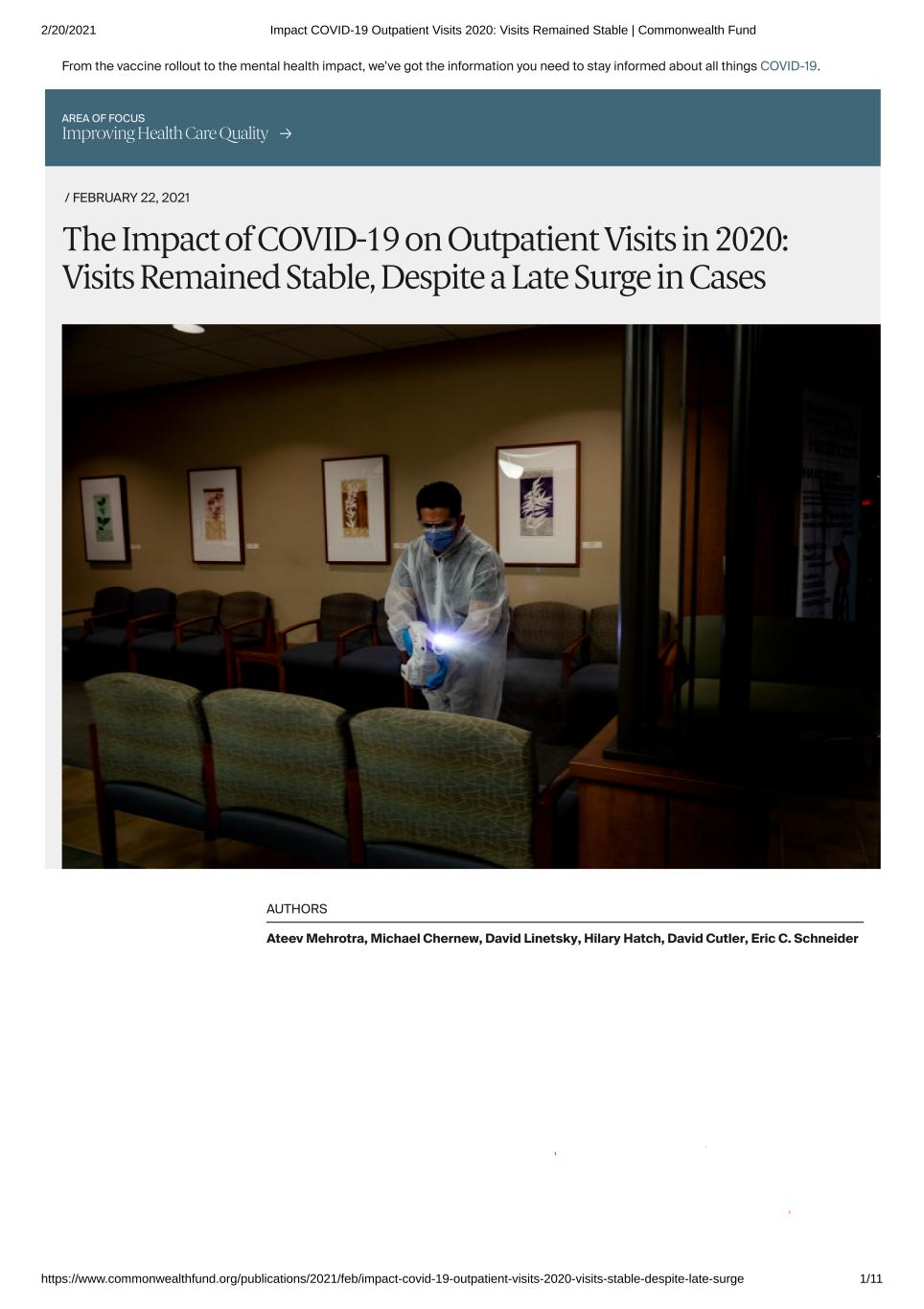
2/20/2021 Impact COVID-19 Outpatient Visits 2020: Visits Remained Stable | Commonwealth Fund https://www.commonwealthfund.org/publications/2021/feb/impact-covid-19-outpatient-visits-2020-visits-stable-despite-late-surge 1/11 From the vaccine rollout to the mental health impact, we’ve got the information you need to stay informed about all things COVID-19. AREA OF FOCUS Improving Health Care Quality / FEBRUARY 22, 2021 The Impact of COVID-19 on Outpatient Visits in 2020: Visits Remained Stable, Despite a Late Surge in Cases AUTHORS Ateev Mehrotra, Michael Chernew, David Linetsky, Hilary Hatch, David Cutler, Eric C. Schneider EMBARGOED — Not for release before 12:01 a.m. ET, Monday,

2/20/2021 Impact COVID-19 Outpatient Visits 2020: Visits Remained Stable | Commonwealth Fund https://www.commonwealthfund.org/publications/2021/feb/impact-covid-19-outpatient-visits-2020-visits-stable-despite-late-surge 2/11 February 22, 2021. The COVID-19 pandemic dramatically altered the delivery of outpatient care in 2020. Beginning in March, health care practices began deferring elective visits, modifying their practices to safely accommodate in-person visits, and increasing the use of telemedicine. Since the start of the pandemic, we have issued a series of reports tracking weekly outpatient visit volume. In April, we reported that the number of visits to ambulatory care providers had declined by nearly 60 percent. By May, visits had rebounded, though they were still below the prepandemic baseline. In our August update, we described modest drops in visits in some of the COVID-19 hot- spot states. By October, office visit volumes had essentially returned to baseline, and telemedicine use showed signs of declining. In this, our sixth report, we describe visits through the end of 2020. Over November and December, the nation witnessed an unprecedented rise in COVID-19 cases. Coming on the heels of the holiday season, this COVID-19 surge affected nearly all states, exacerbating several challenges already facing care providers: treating patients exposed to the virus or infected by it; managing patients with non-COVID-19-related illnesses; keeping providers and staff healthy; and ensuring the financial viability of their practices. The charts that follow point to the resiliency of outpatient practices in the face of these challenges, as the number of weekly outpatient visits overall remained stable. However, there were several notable changes in November and December, including a modest shift back to telemedicine and a substantial drop in visits among children. Furthermore, while visit volumes mostly remained stable, they were below the levels for early winter seen in prior years — a time when visit volumes typically rise. By tracking trends in outpatient office visits, we hope to shed light on these questions: Researchers at Harvard University and Phreesia, a health care technology company, analyzed data on changes in visit volume for the more than 50,000 providers that are Phreesia clients. To better understand the impact of the pandemic on visit volumes, we also present outpatient visit volumes averaged over the prior four years. Comparing weekly visits during 2020 to weekly visits during prior years helps us better understand whether changes we have observed are unusual or reflect annual seasonal changes. In addition, we refined the sample of practices we included in the analyses to ensure that changes in practice composition are not driving the shifts in visit volume. Details on these changes, data sources, analyses, and study limitations are available at the bottom of this post. What is the clinical impact of the pandemic, and how accessible has outpatient care been during the pandemic? Are new policies encouraging greater use of telemedicine? What has been the financial impact of the pandemic on health care providers?
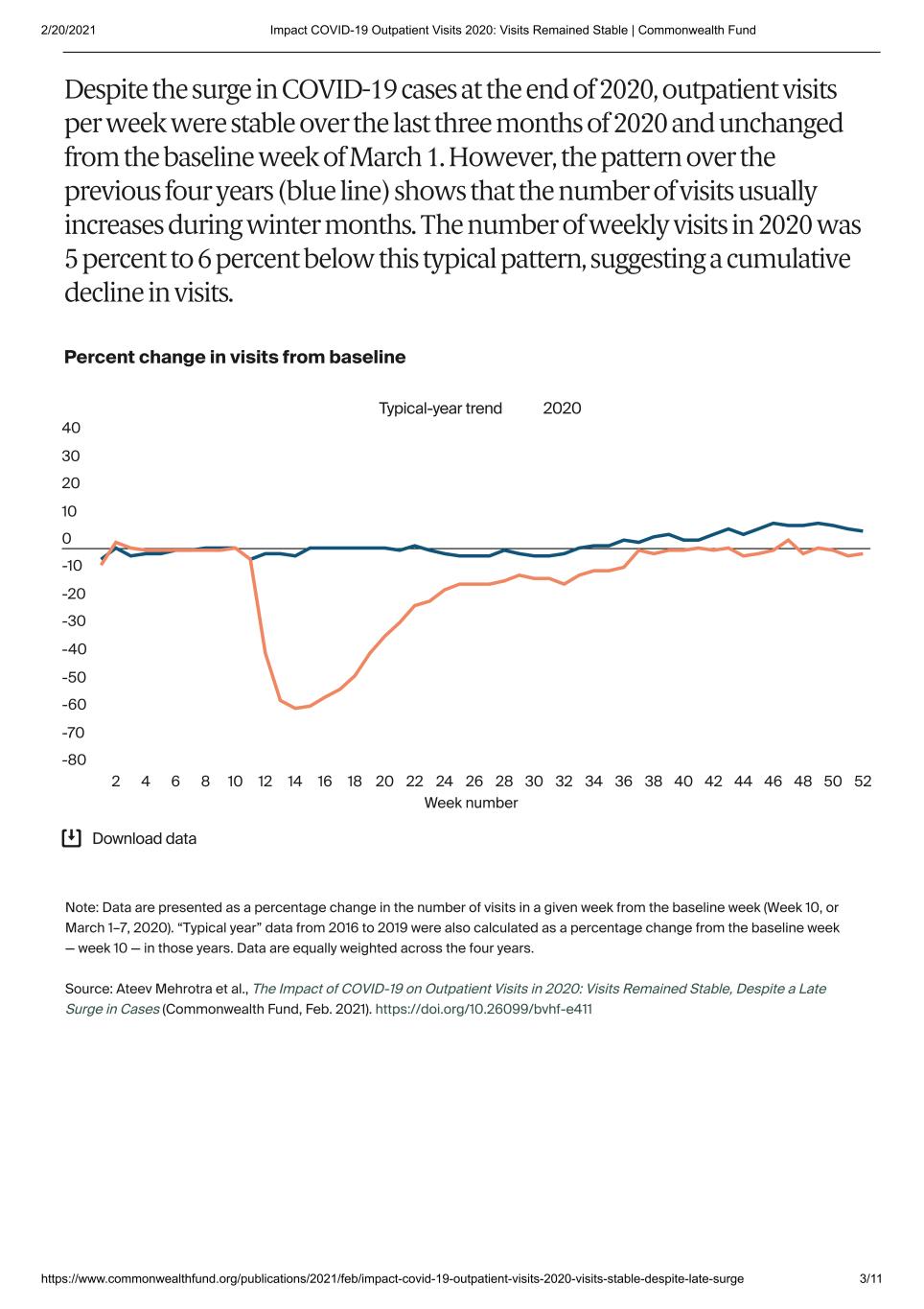
2/20/2021 Impact COVID-19 Outpatient Visits 2020: Visits Remained Stable | Commonwealth Fund https://www.commonwealthfund.org/publications/2021/feb/impact-covid-19-outpatient-visits-2020-visits-stable-despite-late-surge 3/11 Download data -80 -70 -60 -50 -40 -30 -20 -10 0 10 20 30 40 2 4 6 8 10 12 14 16 18 20 22 24 26 28 30 32 34 36 38 40 42 44 46 48 50 52 Week number Typical-year trend 2020 Despite the surge in COVID-19 cases at the end of 2020, outpatient visits per week were stable over the last three months of 2020 and unchanged from the baseline week of March 1. However, the pattern over the previous four years (blue line) shows that the number of visits usually increases during winter months. The number of weekly visits in 2020 was 5 percent to 6 percent below this typical pattern, suggesting a cumulative decline in visits. Percent change in visits from baseline Note: Data are presented as a percentage change in the number of visits in a given week from the baseline week (Week 10, or March 1–7, 2020). “Typical year” data from 2016 to 2019 were also calculated as a percentage change from the baseline week — week 10 — in those years. Data are equally weighted across the four years. Source: Ateev Mehrotra et al., The Impact of COVID-19 on Outpatient Visits in 2020: Visits Remained Stable, Despite a Late Surge in Cases (Commonwealth Fund, Feb. 2021). https://doi.org/10.26099/bvhf-e411
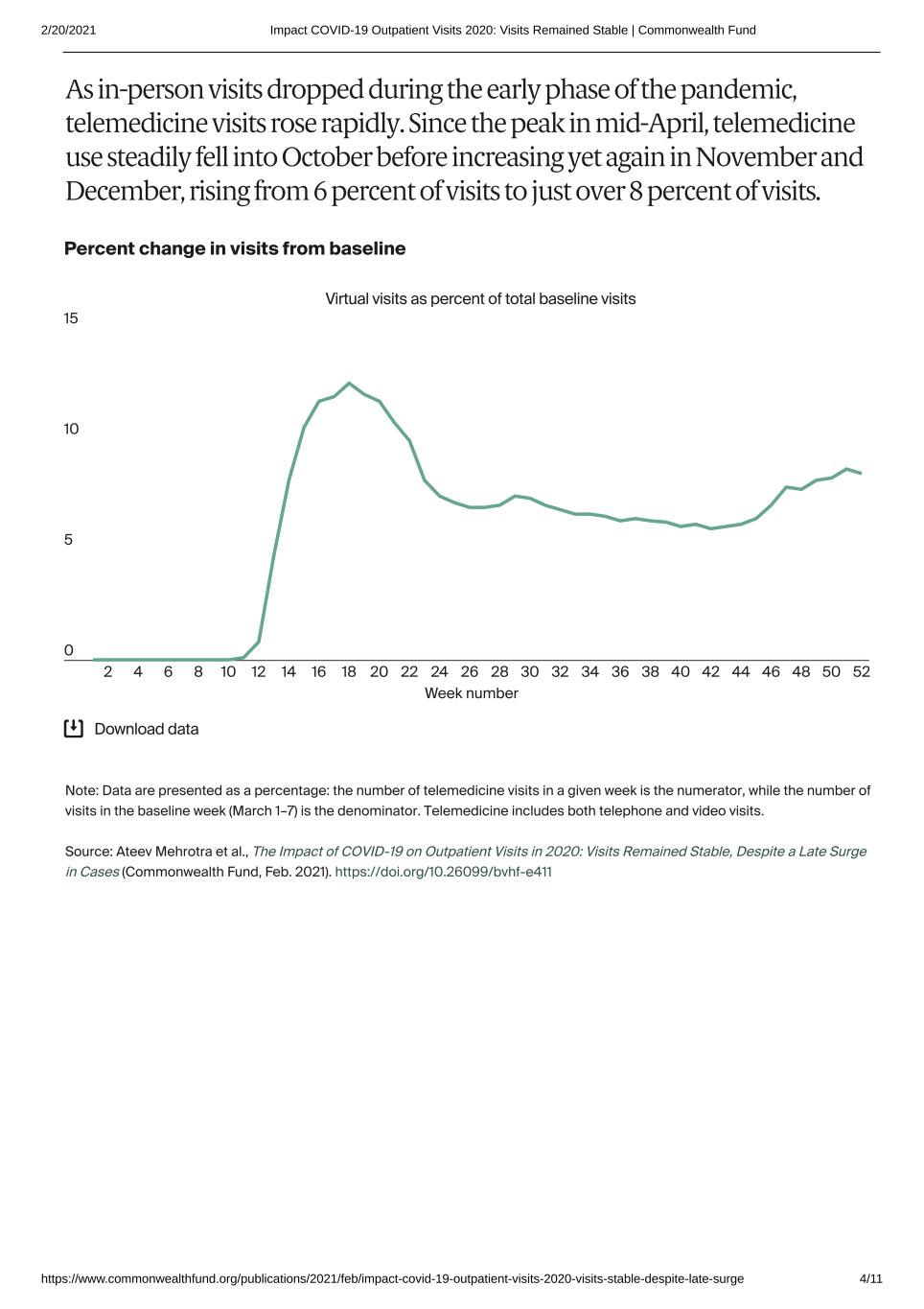
2/20/2021 Impact COVID-19 Outpatient Visits 2020: Visits Remained Stable | Commonwealth Fund https://www.commonwealthfund.org/publications/2021/feb/impact-covid-19-outpatient-visits-2020-visits-stable-despite-late-surge 4/11 Download data 0 5 10 15 2 4 6 8 10 12 14 16 18 20 22 24 26 28 30 32 34 36 38 40 42 44 46 48 50 52 Week number Virtual visits as percent of total baseline visits As in-person visits dropped during the early phase of the pandemic, telemedicine visits rose rapidly. Since the peak in mid-April, telemedicine use steadily fell into October before increasing yet again in November and December, rising from 6 percent of visits to just over 8 percent of visits. Percent change in visits from baseline Note: Data are presented as a percentage: the number of telemedicine visits in a given week is the numerator, while the number of visits in the baseline week (March 1–7) is the denominator. Telemedicine includes both telephone and video visits. Source: Ateev Mehrotra et al., The Impact of COVID-19 on Outpatient Visits in 2020: Visits Remained Stable, Despite a Late Surge in Cases (Commonwealth Fund, Feb. 2021). https://doi.org/10.26099/bvhf-e411

2/20/2021 Impact COVID-19 Outpatient Visits 2020: Visits Remained Stable | Commonwealth Fund https://www.commonwealthfund.org/publications/2021/feb/impact-covid-19-outpatient-visits-2020-visits-stable-despite-late-surge 5/11 Download data Ages 0–2 Ages 3–5 Ages 6–17 Ages 18–64 Ages 65–74 Age 75+ -80 -70 -60 -50 -40 -30 -20 -10 0 10 20 30 40 2 4 6 8 10 12 14 16 18 20 22 24 26 28 30 32 34 36 38 40 42 44 46 48 50 52 Week number Typical-year trend 2020 While numbers of visits overall returned to prepandemic levels, trends varied by age group. Among children ages 3 to 17, weekly visit volumes in 2020 fell after October and ended the year substantially lower than what would be expected in a typical year (the blue line). In contrast, visit volumes for older adults remained more stable. Note: Data are presented as a percentage change in the number of visits in a given week from the baseline week (March 1–7). “Typical year” data from 2016 to 2019 were also calculated as a percentage change from the baseline week — week 10 — of those years. Data are equally weighted across the four years. Source: Ateev Mehrotra et al., The Impact of COVID-19 on Outpatient Visits in 2020: Visits Remained Stable, Despite a Late Surge in Cases (Commonwealth Fund, Feb. 2021). https://doi.org/10.26099/bvhf-e411 Percent change in visits from baseline
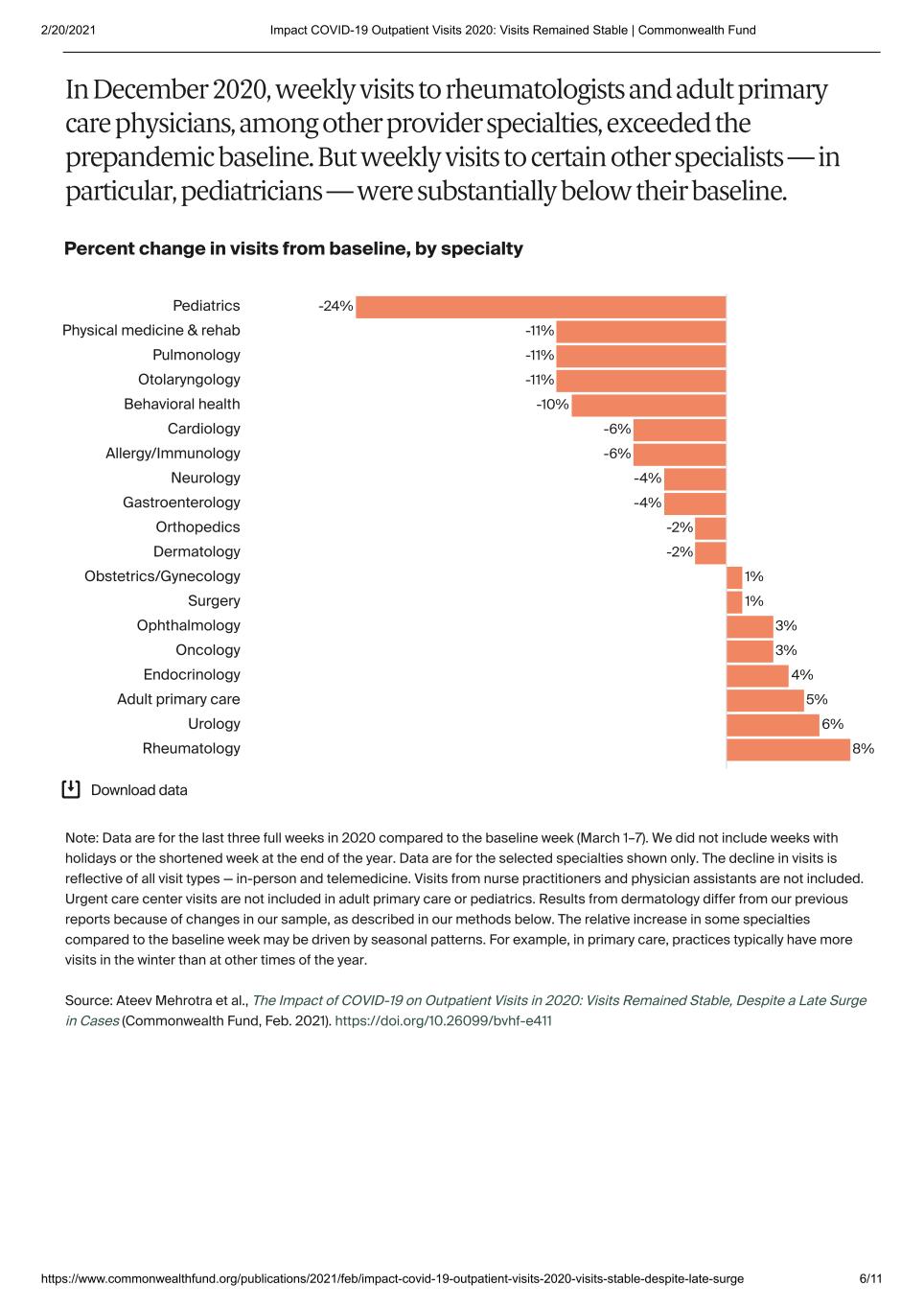
2/20/2021 Impact COVID-19 Outpatient Visits 2020: Visits Remained Stable | Commonwealth Fund https://www.commonwealthfund.org/publications/2021/feb/impact-covid-19-outpatient-visits-2020-visits-stable-despite-late-surge 6/11 Download data Pediatrics Physical medicine & rehab Pulmonology Otolaryngology Behavioral health Cardiology Allergy/Immunology Neurology Gastroenterology Orthopedics Dermatology Obstetrics/Gynecology Surgery Ophthalmology Oncology Endocrinology Adult primary care Urology Rheumatology -24% -11% -11% -11% -10% -6% -6% -4% -4% -2% -2% 1% 1% 3% 3% 4% 5% 6% 8% In December 2020, weekly visits to rheumatologists and adult primary care physicians, among other provider specialties, exceeded the prepandemic baseline. But weekly visits to certain other specialists — in particular, pediatricians — were substantially below their baseline. Percent change in visits from baseline, by specialty Note: Data are for the last three full weeks in 2020 compared to the baseline week (March 1–7). We did not include weeks with holidays or the shortened week at the end of the year. Data are for the selected specialties shown only. The decline in visits is reflective of all visit types — in-person and telemedicine. Visits from nurse practitioners and physician assistants are not included. Urgent care center visits are not included in adult primary care or pediatrics. Results from dermatology differ from our previous reports because of changes in our sample, as described in our methods below. The relative increase in some specialties compared to the baseline week may be driven by seasonal patterns. For example, in primary care, practices typically have more visits in the winter than at other times of the year. Source: Ateev Mehrotra et al., The Impact of COVID-19 on Outpatient Visits in 2020: Visits Remained Stable, Despite a Late Surge in Cases (Commonwealth Fund, Feb. 2021). https://doi.org/10.26099/bvhf-e411
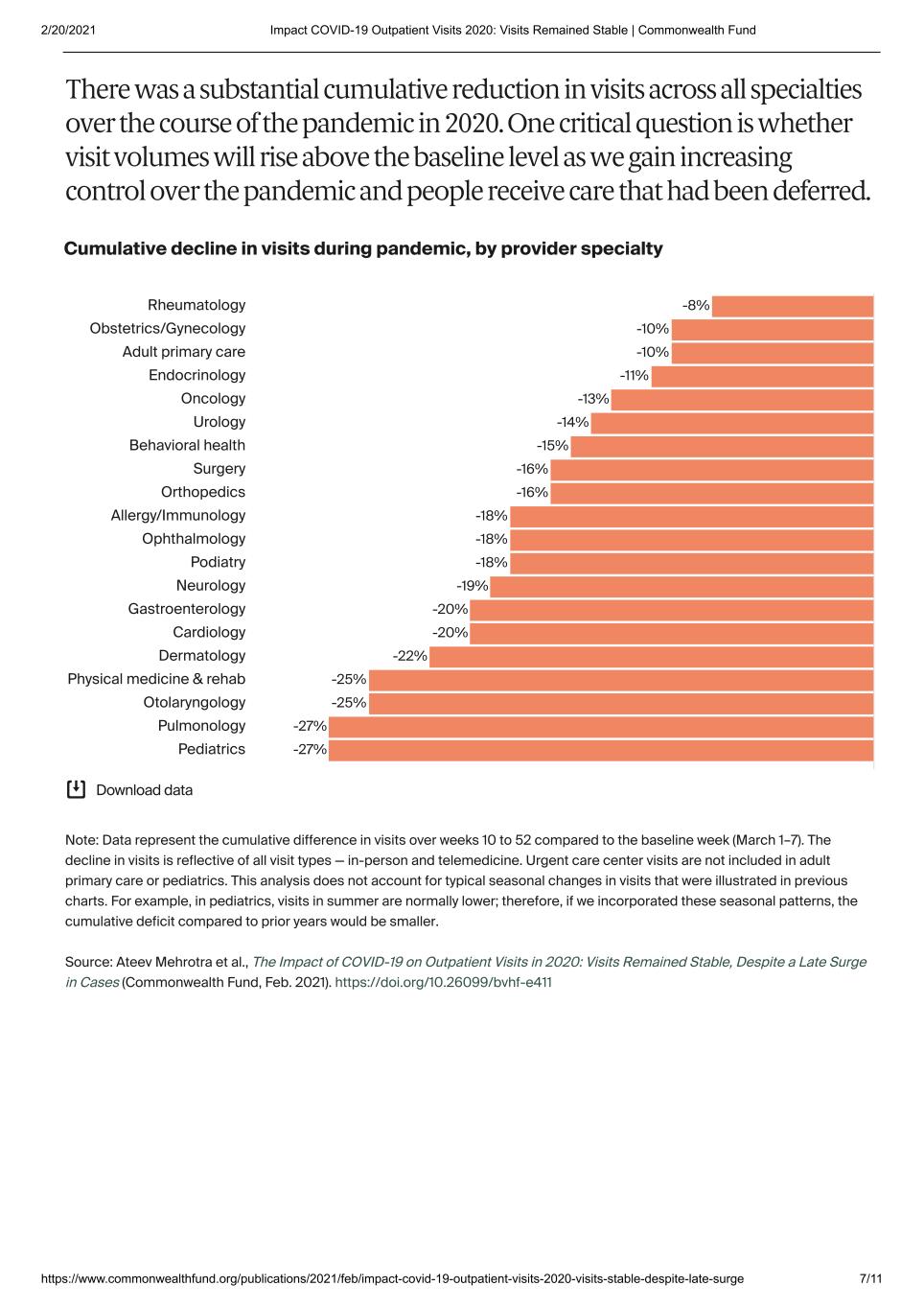
2/20/2021 Impact COVID-19 Outpatient Visits 2020: Visits Remained Stable | Commonwealth Fund https://www.commonwealthfund.org/publications/2021/feb/impact-covid-19-outpatient-visits-2020-visits-stable-despite-late-surge 7/11 Download data Rheumatology Obstetrics/Gynecology Adult primary care Endocrinology Oncology Urology Behavioral health Surgery Orthopedics Allergy/Immunology Ophthalmology Podiatry Neurology Gastroenterology Cardiology Dermatology Physical medicine & rehab Otolaryngology Pulmonology Pediatrics -8% -10% -10% -11% -13% -14% -15% -16% -16% -18% -18% -18% -19% -20% -20% -22% -25% -25% -27% -27% There was a substantial cumulative reduction in visits across all specialties over the course of the pandemic in 2020. One critical question is whether visit volumes will rise above the baseline level as we gain increasing control over the pandemic and people receive care that had been deferred. Cumulative decline in visits during pandemic, by provider specialty Note: Data represent the cumulative difference in visits over weeks 10 to 52 compared to the baseline week (March 1–7). The decline in visits is reflective of all visit types — in-person and telemedicine. Urgent care center visits are not included in adult primary care or pediatrics. This analysis does not account for typical seasonal changes in visits that were illustrated in previous charts. For example, in pediatrics, visits in summer are normally lower; therefore, if we incorporated these seasonal patterns, the cumulative deficit compared to prior years would be smaller. Source: Ateev Mehrotra et al., The Impact of COVID-19 on Outpatient Visits in 2020: Visits Remained Stable, Despite a Late Surge in Cases (Commonwealth Fund, Feb. 2021). https://doi.org/10.26099/bvhf-e411
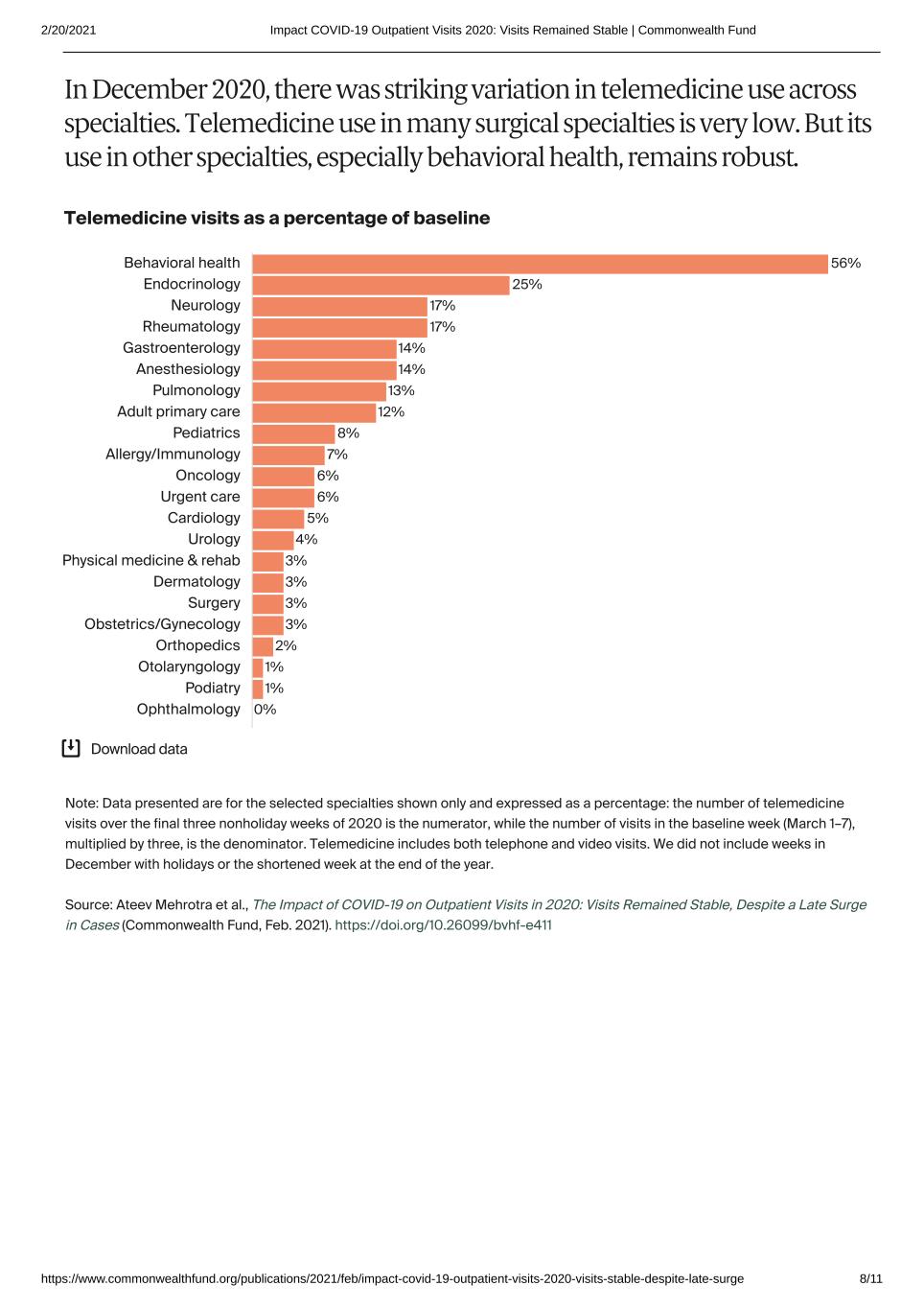
2/20/2021 Impact COVID-19 Outpatient Visits 2020: Visits Remained Stable | Commonwealth Fund https://www.commonwealthfund.org/publications/2021/feb/impact-covid-19-outpatient-visits-2020-visits-stable-despite-late-surge 8/11 Download data Behavioral health Endocrinology Neurology Rheumatology Gastroenterology Anesthesiology Pulmonology Adult primary care Pediatrics Allergy/Immunology Oncology Urgent care Cardiology Urology Physical medicine & rehab Dermatology Surgery Obstetrics/Gynecology Orthopedics Otolaryngology Podiatry Ophthalmology 56% 25% 17% 17% 14% 14% 13% 12% 8% 7% 6% 6% 5% 4% 3% 3% 3% 3% 2% 1% 1% 0% In December 2020, there was striking variation in telemedicine use across specialties. Telemedicine use in many surgical specialties is very low. But its use in other specialties, especially behavioral health, remains robust. Telemedicine visits as a percentage of baseline Note: Data presented are for the selected specialties shown only and expressed as a percentage: the number of telemedicine visits over the final three nonholiday weeks of 2020 is the numerator, while the number of visits in the baseline week (March 1–7), multiplied by three, is the denominator. Telemedicine includes both telephone and video visits. We did not include weeks in December with holidays or the shortened week at the end of the year. Source: Ateev Mehrotra et al., The Impact of COVID-19 on Outpatient Visits in 2020: Visits Remained Stable, Despite a Late Surge in Cases (Commonwealth Fund, Feb. 2021). https://doi.org/10.26099/bvhf-e411
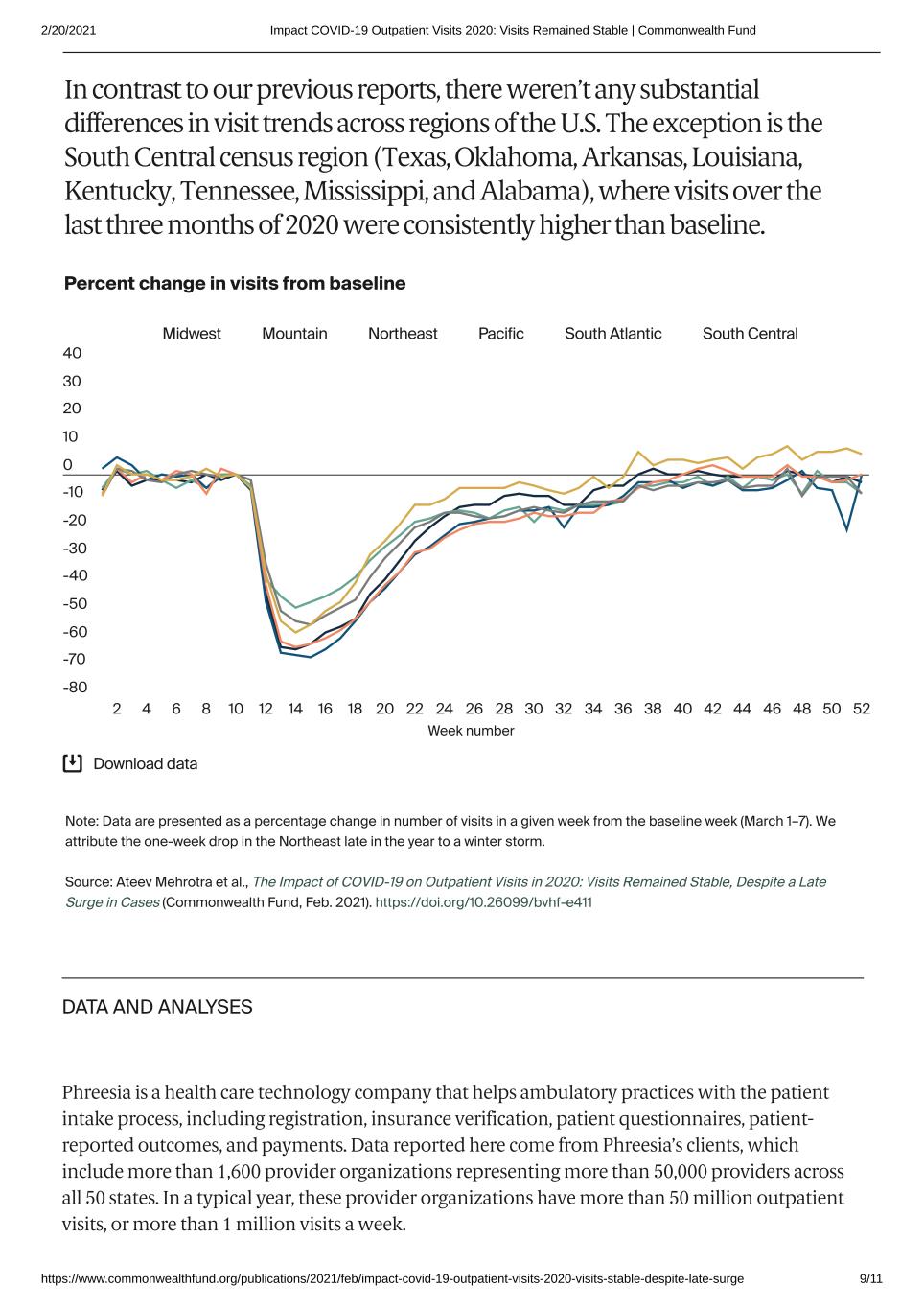
2/20/2021 Impact COVID-19 Outpatient Visits 2020: Visits Remained Stable | Commonwealth Fund https://www.commonwealthfund.org/publications/2021/feb/impact-covid-19-outpatient-visits-2020-visits-stable-despite-late-surge 9/11 Download data -80 -70 -60 -50 -40 -30 -20 -10 0 10 20 30 40 2 4 6 8 10 12 14 16 18 20 22 24 26 28 30 32 34 36 38 40 42 44 46 48 50 52 Week number Midwest Mountain Northeast Pacific South Atlantic South Central In contrast to our previous reports, there weren’t any substantial differences in visit trends across regions of the U.S. The exception is the South Central census region (Texas, Oklahoma, Arkansas, Louisiana, Kentucky, Tennessee, Mississippi, and Alabama), where visits over the last three months of 2020 were consistently higher than baseline. Percent change in visits from baseline Note: Data are presented as a percentage change in number of visits in a given week from the baseline week (March 1–7). We attribute the one-week drop in the Northeast late in the year to a winter storm. Source: Ateev Mehrotra et al., The Impact of COVID-19 on Outpatient Visits in 2020: Visits Remained Stable, Despite a Late Surge in Cases (Commonwealth Fund, Feb. 2021). https://doi.org/10.26099/bvhf-e411 DATA AND ANALYSES Phreesia is a health care technology company that helps ambulatory practices with the patient intake process, including registration, insurance verification, patient questionnaires, patient- reported outcomes, and payments. Data reported here come from Phreesia’s clients, which include more than 1,600 provider organizations representing more than 50,000 providers across all 50 states. In a typical year, these provider organizations have more than 50 million outpatient visits, or more than 1 million visits a week.
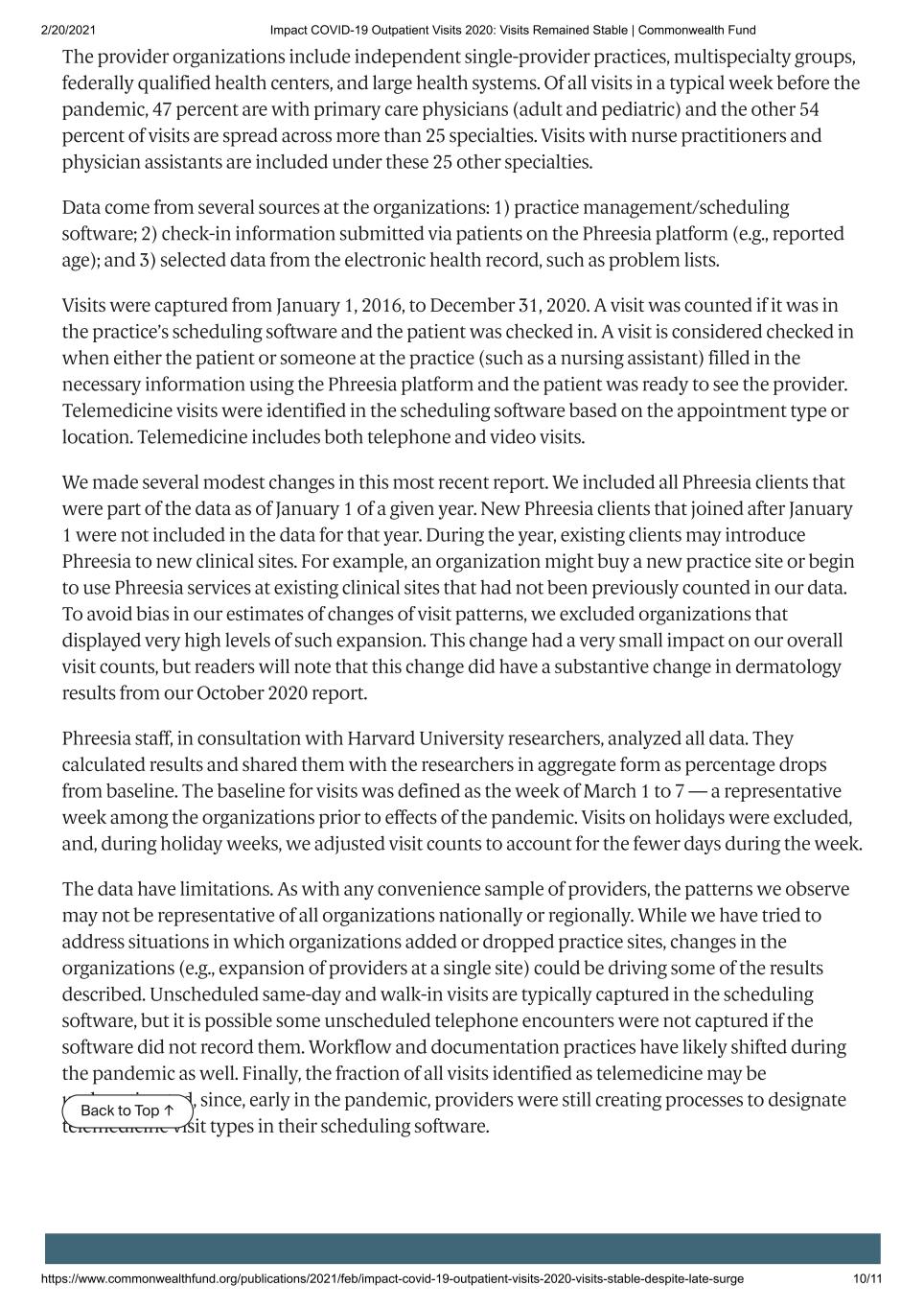
2/20/2021 Impact COVID-19 Outpatient Visits 2020: Visits Remained Stable | Commonwealth Fund https://www.commonwealthfund.org/publications/2021/feb/impact-covid-19-outpatient-visits-2020-visits-stable-despite-late-surge 10/11 The provider organizations include independent single-provider practices, multispecialty groups, federally qualified health centers, and large health systems. Of all visits in a typical week before the pandemic, 47 percent are with primary care physicians (adult and pediatric) and the other 54 percent of visits are spread across more than 25 specialties. Visits with nurse practitioners and physician assistants are included under these 25 other specialties. Data come from several sources at the organizations: 1) practice management/scheduling software; 2) check-in information submitted via patients on the Phreesia platform (e.g., reported age); and 3) selected data from the electronic health record, such as problem lists. Visits were captured from January 1, 2016, to December 31, 2020. A visit was counted if it was in the practice’s scheduling software and the patient was checked in. A visit is considered checked in when either the patient or someone at the practice (such as a nursing assistant) filled in the necessary information using the Phreesia platform and the patient was ready to see the provider. Telemedicine visits were identified in the scheduling software based on the appointment type or location. Telemedicine includes both telephone and video visits. We made several modest changes in this most recent report. We included all Phreesia clients that were part of the data as of January 1 of a given year. New Phreesia clients that joined after January 1 were not included in the data for that year. During the year, existing clients may introduce Phreesia to new clinical sites. For example, an organization might buy a new practice site or begin to use Phreesia services at existing clinical sites that had not been previously counted in our data. To avoid bias in our estimates of changes of visit patterns, we excluded organizations that displayed very high levels of such expansion. This change had a very small impact on our overall visit counts, but readers will note that this change did have a substantive change in dermatology results from our October 2020 report. Phreesia staff, in consultation with Harvard University researchers, analyzed all data. They calculated results and shared them with the researchers in aggregate form as percentage drops from baseline. The baseline for visits was defined as the week of March 1 to 7 — a representative week among the organizations prior to effects of the pandemic. Visits on holidays were excluded, and, during holiday weeks, we adjusted visit counts to account for the fewer days during the week. The data have limitations. As with any convenience sample of providers, the patterns we observe may not be representative of all organizations nationally or regionally. While we have tried to address situations in which organizations added or dropped practice sites, changes in the organizations (e.g., expansion of providers at a single site) could be driving some of the results described. Unscheduled same-day and walk-in visits are typically captured in the scheduling software, but it is possible some unscheduled telephone encounters were not captured if the software did not record them. Workflow and documentation practices have likely shifted during the pandemic as well. Finally, the fraction of all visits identified as telemedicine may be underestimated, since, early in the pandemic, providers were still creating processes to designate telemedicine visit types in their scheduling software. Back to Top ↑

2/20/2021 Impact COVID-19 Outpatient Visits 2020: Visits Remained Stable | Commonwealth Fund https://www.commonwealthfund.org/publications/2021/feb/impact-covid-19-outpatient-visits-2020-visits-stable-despite-late-surge 11/11 PUBLICATION DETAILS DATE February 22, 2021 CONTACT Ateev Mehrotra, Associate Professor of Health Care Policy and Medicine [email protected] CITATION Ateev Mehrotra et al., The Impact of COVID-19 on Outpatient Visits in 2020: Visits Remained Stable, Despite a Late Surge in Cases (Commonwealth Fund, Feb. 2021). https://doi.org/10.26099/bvhf-e411 AREA OF FOCUS Improving Health Care Quality TOPICS Delivery System Reform, Coverage and Access, Conditions and Illnesses, COVID-19
Serious News for Serious Traders! Try StreetInsider.com Premium Free!
You May Also Be Interested In
- Notice of AGM
- Spar Nord repays Tier 2 capital with ISINs DK0030431341 and DK0030432075
- Umicore update on trading conditions over the first quarter of 2024
Create E-mail Alert Related Categories
SEC FilingsSign up for StreetInsider Free!
Receive full access to all new and archived articles, unlimited portfolio tracking, e-mail alerts, custom newswires and RSS feeds - and more!



 Tweet
Tweet Share
Share